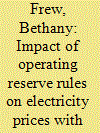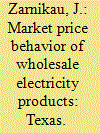|
|
|
Sort Order |
|
|
|
Items / Page
|
|
|
|
|
|
|
| Srl | Item |
| 1 |
ID:
125810


|
|
|
|
|
| Publication |
2013.
|
| Summary/Abstract |
An impact of increased variable renewable generation is the need for balancing authorities to procure more ancillary services. While demand response resources are technically capable of providing these services, current experience across the U.S. illustrates they are relatively minor players in most regions. Accessing demand response resources for ancillary services may require a number of changes to policies and common practices at multiple levels. Regional reliability councils must first define ancillary services such that demand response resources may provide them. Once the opportunity exists, balancing authorities define and promulgate rules that set the infrastructure investments and performance attributes of a resource wishing to provide such services. These rules also dictate expected revenue streams which reveal the cost effectiveness of these resources. The regulatory compact between utility and state regulators, along with other statutes and decisions by state policymakers, may impact the interest of demand response program providers to pursue these resources as ancillary service providers. This paper identifies within these broad categories specific market and policy barriers to demand response providing ancillary services in different wholesale and retail environments, with emphasis on smaller customers who must be aggregated through a program provider to meet minimum size requirements for wholesale transactions.
|
|
|
|
|
|
|
|
|
|
|
|
|
|
|
|
| 2 |
ID:
117290


|
|
|
|
|
| Publication |
2013.
|
| Summary/Abstract |
Ancillary services are required to maintain the unity, stability, and quality of power systems. In Colombia these services are required to operate the national power system and the international connections with the neighboring countries. The system is influenced by factors ranging from system's topology to social and political aspects, such as the large number of terrorist attacks. In light of these particularities, we consider Colombia as a learning lab for ancillary services in the region. Colombia's power system relies on three ancillary services for its operation, namely frequency regulation, voltage control, and blackstart service. From 2010 Special Protection Systems were also added. In this paper we first analyze the technical aspects, operational restrictions, financial management, and the most relevant regulatory conditions of these ancillary services of the SIN. We also take into consideration the main regulatory characteristics and statistical data related to energy exchanges that have taken place between Colombia and Venezuela and Ecuador. Thereafter, we depict the main weaknesses and policy challenges that Colombia must address in order to increase the effectiveness and coverage of ancillary services in both the SIN and in the international interconnections. Finally, we propose new market oriented regulations to encourage investments and new tools for international connections.
|
|
|
|
|
|
|
|
|
|
|
|
|
|
|
|
| 3 |
ID:
180868


|
|
|
|
|
| Summary/Abstract |
Increasing variable renewable energy penetration, climate change, and global uncertainties will make it harder to stabilize and balance power systems. This situation will be especially challenging for developing economies with limited capital and institutional capacity, poor infrastructure, and rapid economic growth. Using the Philippines as a case study for a developing economy, the paper identified chronic underinvestment in the supply of ancillary services that play a crucial role in balancing energy supply with demand and building grid resilience. To diagnose the cause, the paper created a novel dataset with all ancillary services revenue contracts in effect at the end of 2019 and analyzed their key terms and conditions. The paper concludes that these contracts are not conducive to financing due to short durations, low and soft buying commitments, exclusive focus on incumbent versus new entrants, hour and season constraints, and a poorly implemented remuneration methodology. The literature rarely analysis this topic from a financing perspective and at this level of detail. Revenue contracts need to switch to long-term, firm, and technology-specific cost recovery mechanisms with new entrants, to incentivize financing. Storage technologies such as batteries and hydropower should be prioritized, followed by gas turbines. These changes will result in a more secure, resilient, and affordable power system.
|
|
|
|
|
|
|
|
|
|
|
|
|
|
|
|
| 4 |
ID:
088039


|
|
|
|
|
| Publication |
2009.
|
| Summary/Abstract |
Although the markets for ancillary services at the North American Independent System Operators are often structured in quite different ways there is an emerging set of core design elements that represent a rough consensus as to what the optimal design configuration for ancillary services should be, albeit with some regional variation. This paper looks back at how the design of ancillary services markets has recently evolved to put this development in context. Thereafter it examines the methods by which ancillary services are procured by highlighting the procurement practices at a number of different Independent System Operators, principally those in California, New York, New England, Texas and the PJM Interconnection, in an attempt to tease out the remaining reasons why the ancillary service markets are still so different. This is important as there are many innovations that are not rooted in regional differences but reflect genuine technical advances and economic efficiency gains and can be replicated across other ISOs to produce more efficient designs, greater reliability and lower costs.
|
|
|
|
|
|
|
|
|
|
|
|
|
|
|
|
| 5 |
ID:
179685


|
|
|
|
|
| Summary/Abstract |
In competitive wholesale electricity markets, significant effort is devoted to designing markets that set efficient prices for maintaining supply-demand balance. One factor that can impact prices is administratively-set scarcity pricing, which sets prices to a preset level when the market is not able to meet operating reserve or energy requirements. When energy and operating reserves are co-optimized, assumptions surrounding operating reserve requirements and scarcity pricing can impact system-wide price outcomes for both operating reserves and energy. This study uses production cost modeling of an ERCOT-like system to evaluate the impact of operating reserve eligibility, scarcity pricing, and quantity rules on electricity prices, and therefore also on generator revenues. Results reveal economic and operational benefits with allowing open participation in reserve markets, as this enables greater access to the full set of capable resources at lowest cost. Furthermore, both energy and reserve prices are strongly impacted by reserve scarcity pricing events, which reveals that reserve scarcity pricing assumptions can impact price outcomes even for units not providing reserves. This study highlights the importance of operating reserve scarcity pricing rules because of the strong coupling between energy and reserve prices and because these rules serve as proxies for true price responsive demand.
|
|
|
|
|
|
|
|
|
|
|
|
|
|
|
|
| 6 |
ID:
121276


|
|
|
|
|
| Publication |
2013.
|
| Summary/Abstract |
Many pre-existing air conditioner load control programs can provide valuable operational flexibility but have not been incorporated into electricity ancillary service markets or grid operations. Multiple demonstrations have shown that residential air conditioner (AC) response can deliver resources quickly and can provide contingency reserves. A key policy hurdle to be overcome before AC load control can be fully incorporated into markets is how to balance the accuracy, cost, and complexity of methods available for the settlement of load curtailment. Overcoming this hurdle requires a means for assessing the accuracy of shorter-term AC load control demand reduction estimation approaches in an unbiased manner. This paper applies such a method to compare the accuracy of approaches varying in cost and complexity - including regression analysis, load matching and control group approaches - using feeder data, household data and AC end-use data. We recommend a practical approach for settlement, relying on an annually updated set of tables, with pre-calculated reduction estimates. These tables allow users to look up the demand reduction per device based on daily maximum temperature, geographic region and hour of day, simplifying settlement and providing a solution to the policy problem presented in this paper.
|
|
|
|
|
|
|
|
|
|
|
|
|
|
|
|
| 7 |
ID:
088970


|
|
|
|
|
| Publication |
2009.
|
| Summary/Abstract |
Ancillary services (AS) management has become an important issue to be addressed in the Indian power system after adaption of the restructuring and unbundling processes following the enactment of Indian Electricity Act 2003. In an electricity market, frequency regulation is one of the ancillary services, which must be procured by the system operator (SO) from the market participants by some regulatory mechanism or using market-based approaches. It is important for the SO to optimally procure this service from the AS market. In this paper, an approach for determining the optimal frequency regulation service procurement has been proposed for equitable payment to generators and recovery from the customers. The effectiveness of the proposed method has been demonstrated on a practical Northern Regional Electricity Board (NREB) system of India.
|
|
|
|
|
|
|
|
|
|
|
|
|
|
|
|
| 8 |
ID:
125719


|
|
|
|
|
| Publication |
2013.
|
| Summary/Abstract |
Real-time balancing of mismatches between consumption and production is one of the key elements for the secure operation of power systems. This takes place within the framework of ancillary services managed by respective national transmission system operating companies. The objective of this paper is to investigate the option of one integrated pan-European ancillary services market. Our contribution is twofold: quantifying the potential benefit of such an option and outlining a possible approach to such an option highlighting its positive properties as well as risks and challenges. In several recently published considerations of pan-European electricity supply models this topic has not been adequately addressed, but we believe it is one of the crucial subjects in shaping the future electricity supply in Europe.
|
|
|
|
|
|
|
|
|
|
|
|
|
|
|
|
| 9 |
ID:
162941


|
|
|
|
|
| Summary/Abstract |
Applying a regression-based approach to a newly developed sample of over 60,000 hourly observations for 01/01/2011–12/30/2017, we answer the question: what moves the day-ahead market (DAM) prices for energy and ancillary services (AS) and the real-time market (RTM) price for energy in the Electric Reliability Council of Texas (ERCOT)? Our answer comprises the following findings that capture the interdependence of ERCOT's energy and AS products: (1) the DAM energy price increases with the day-ahead forecasts of natural gas price, system load and AS requirements but declines with nuclear and wind generation's forecasts; (2) the AS prices increase with the DAM energy price and the AS procurement forecasts but decline with the AS offer forecasts; and (3) the RTM energy price increases with the DAM energy price but diverges from the DAM energy price due to forecasting errors related to the DAM energy price's fundamental drivers. These findings imply that Texas can reduce the prices for day-ahead energy, day-ahead AS and real-time energy via wind generation development and demand-side-management. Further, Texas can improve its electricity trading efficiency by improving ERCOT's forecast accuracy to narrow the RTM energy price's divergence from the DAM energy price.
|
|
|
|
|
|
|
|
|
|
|
|
|
|
|
|
| 10 |
ID:
176098


|
|
|
|
|
| Summary/Abstract |
The UK's transition to a zero-carbon economy is inevitably leading to an electricity grid with a high penetration of intermittent renewable energy generation, resulting in the need to install grid-scale energy storage systems at an accelerating rate. This study has taken the perspective of a business owner to assess the profitability of deploying battery technologies in the UK electricity market by analysing arbitrage in electricity markets, capacity market auctions, and ancillary services (frequency response and reserve). Additional work was conducted for integrating battery arbitrage cycling with solar and wind generation, comparing the utilisation of a linear programming model against a simplistic threshold cycling model. An overall economic assessment of value streams found that the lowest payback periods for premium ancillary services were 3.3 years (advanced lead-acid battery providing fast reserve) and 6.6 years (lithium-ion battery providing frequency response). Moreover, this research has demonstrated promising returns on investment for stacking short-term operating reserve with arbitrage in the balancing market. In the near future, battery systems will likely attain accelerated deployment due to reforms in ancillary service structures, cost reductions in battery technologies, greater price volatility in the balancing market, and effective policy incentives introduced by the UK government.
|
|
|
|
|
|
|
|
|
|
|
|
|
|
|
|
| 11 |
ID:
171366


|
|
|
|
|
| Summary/Abstract |
Vehicle-to-Anything (V2X) is an umbrella term to explain the use of electric vehicle batteries to derive additional value during times of non-use. V2X services generate revenue from the battery asset through dynamic (V1X) or bi-directional (V2X) charging to provide benefits to the electric grid, to reduce energy consumption of buildings and homes, or to provide back-up power to loads. While relatively unknown and still regarded as a nascent technology, V2X exhibits low capital costs and enabling costs have decreased by 90% since 2014.
We present the V2X Value Stream Framework as a means to better communicate and categorize its full economic potential. A meta-analysis of Value Stream potential gives results contradictory to the literature and indicates that Bill Management, Resource Adequacy, and Network Deferral are more valuable than Energy Arbitrage and Spinning Reserves. We distinguish between Energy and Power Value Streams and show how the latter cause less battery degradation and allow for greater stacking of services. Finally, energy policy recommendations are given to better integrate V2X. While we concur that development is of and by the market, we emphasize that V2X will develop within the constraints of the regulatory environment; therefore regulators have an enabling role to play.
|
|
|
|
|
|
|
|
|
|
|
|
|
|
|
|
|
|
|
|
|